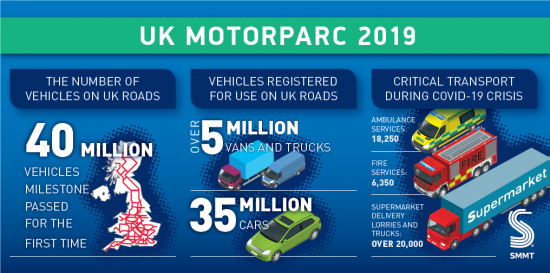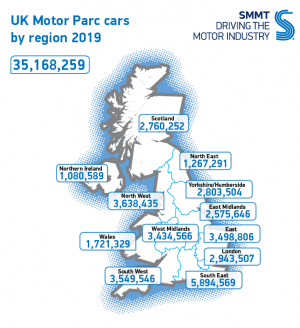UK motorists drive over 40 million cars and vans
 Source: SMMT
Source: SMMT
The UK vehicle parc passed 40 million for the first time, according to new Motorparc data released today by the Society of Motor Manufacturers and Traders (SMMT). The UK’s largest automotive analysis reveals that more than 35 million cars and five million commercial vehicles were in use in the UK in 2019, representing a 1.0% increase on the previous year.
Light commercial vehicles saw the biggest percentage growth, rising 2.7% on the previous year to 4,527,724 units, surging by 28% in the last decade. Passenger cars, meanwhile, increased 0.8% to 35,168,259 over the same period, as the number of heavy goods vehicles grew by 0.4% to 607,998 – the largest number delivering for Britain since 1990.
Many of these vehicles are helping to provide transport for essential workers, deliveries and emergency services. Some 25,000 ambulance and fire service vehicles, together with more than 20,000 supermarket delivery trucks and lorries are keeping the nation safe, supermarket shelves stocked, and the flow of food, medicine and care to vulnerable people going during the coronavirus crisis. Equally crucial to keeping the cogs turning are the garages that have kept their doors open to ensure these vehicles remain safe and operational during this time of need.
The data also reveals that the UK’s 40 million-strong fleet now includes more than three quarters of a million low, ultra-low and zero emission cars. The number of these cars grew by 26% last year, with 11,832 hybrids, 144,335 plug-in hybrids and 92,913 battery electric vehicles now in use, although this segment still makes up just 2.2% of the overall car parc. Meanwhile the number of diesel cars in use fell marginally by -0.9% to 13,723,299, accounting for 39% of the parc, while petrol cars grew by 1.2% to 20,657,838.
With more drivers opting for the latest low emission vehicle technology, average CO2 emissions continue to fall across the parc – down -19.2% since 2008 to the lowest on record.4 Manufacturer investment in new technologies, from Euro 6 petrols and diesels, to plug-ins and hybrids, mean drivers and operators can now take advantage of a diverse range of efficient models and specifications that best suit their needs.
The most popular vehicles
The most popular car on the road is a black, 8-year old supermini – most likely a Ford Fiesta (1.61m) or a Vauxhall Corsa (1.16m).
White is overwhelmingly the colour of choice for plug-in cars, though only fifth favourite overall.
Meanwhile, the number of female drivers continues to grow as there are now 175,821 more female drivers – up 1.5% on 2018’s parc data to 34.7%.
Greater London and the West Midlands were the only two regions that experienced a decline in car ownership, down -0.31% and -0.71% respectively, with 9,131 and 24,642 fewer cars on the roads across the nation’s capital and the Black Country respectively.
The South West region experienced the country’s most significant uplift in ownership – up 1.94%, with over 67,000 more cars on the roads.
Greater London is the municipality with the highest number of battery electric and plug-in hybrid cars (26,513), followed closely by Birmingham (24,431) and Peterborough (12,493).
2019 saw the highest number of HGVs on UK roads in 30 years – with 607,998 trucks and lorries delivering goods across the country, the majority of them diesel (93.96%).
Record 4,527,724 vans on UK roads supporting booming demand for online deliveries, as 83% of people are buying goods and services online.
Mike Hawes, SMMT Chief Executive, said, “As the UK continues to battle the coronavirus pandemic, keeping food, medical supplies and the people serving on the front line moving has never been so important – and these figures show the essential role Britain’s vehicle fleet plays for society. They also provide evidence that industry’s ongoing investment into ever cleaner, safer and more reliable vehicle technology is paying off, even as demand for mobility grows. To ensure this trend continues, we must get the right support for businesses and their workers in place now so that wh

Regional vehicle ownership
en this crisis is over, the sector can help get the whole country and our economy back on the move.”
The Motorparc data also reveals black as the most commonly seen car colour on the UK’s roads, with more than a fifth clad in the paint. Silver (18%) and blue (17%) are second and third choice respectively for motorists across the country and, while white (13%) takes just fifth place overall, it is the most popular colour for battery electric and hybrid plug-in cars.
Across the country, all regions have seen an increase in ownership, the highest spike in drivers being in the South West of the country, up 1.94%. Conversely, Greater London and the West Midlands were the only two regions that experienced a decline in car ownership, down -0.31% and -0.71% respectively, with 9,131 and 24,642 fewer cars on the roads across the nation’s capital and the Black Country respectively.
In spite of this, the biggest city in the region, Birmingham has the second highest number of battery electric and plug-in hybrid vehicles after Greater London, with some 24,000 zero and ultra-low emission cars on the city’s roads.




Comments